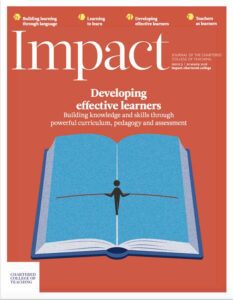It’s good to talk: Moving towards dialogic teaching

Introduction
In 2004, Robin Alexander published his seminal work Towards Dialogic Teaching: Rethinking Classroom Talk (Alexander, 2017, 2020). Now in its fifth edition, this excellent pocket-sized book is a must read for educators, across all phases, interested in developing a more dialogic approach to their classroom practice. Dialogic teaching utilises the power of classroom talk to challenge and stretch students’ thinking and, in the process, aid their cognitive, social and linguistic development. Alexander (Alexander, 2017, 2020) provides a number of justifications for using classroom talk, from the communicative to the cultural, and the political to the pedagogical. Ultimately, it is argued that dialogue should be viewed as the true foundation of teaching and learning. In the UK, however, dialogue is still not afforded the same status as it is in other European countries where oracy is valued as highly as reading and writing.
Creating a truly dialogic classroom requires careful planning, mutually respectful relationships and skilful facilitation. That said, it should not be thought of as a single teaching method but rather as a wide range of strategies and techniques which recognises and respects the complexities and uniqueness of different classroom contexts. This short article will outline the main principles of Alexander’s (Alexander, 2020) dialogic teaching and why dialogue is so important for teachers and students alike.
Main principles of dialogic teaching
Alexander’s dialogic teaching framework includes six repertoires, one of which is ‘teaching talk’, which includes five main types of classroom talk; rote, recitation, instruction, discussion and dialogue (see Alexander, 2018, pp. 7–10). While he recognises that they all have a place in the classroom, dialogue not only has greater cognitive potential for students but also demands more of a teacher’s subject knowledge and pedagogical skill, especially through the use of scaffolding and effective questioning. Dialogue moves beyond other forms of classroom talk such as rote and recitation and assumes a more conversational manner. This is achieved by adhering to a number of key principles (Alexander, 2017, pp. 27-28). Indeed, dialogic teaching is:
Collective
The teacher and students address learning activities together rather than in isolation. Here, the teacher acts as a full partner in discussions with students.In this sense, dialogue becomes a human shared experience that can challenge some of the power dynamics in the classroom. One of the approaches for developing collective dialogue is through the creation of a democratic community of enquiry, providing a ‘dialogic space to agree/ disagree, challenge, question, appeal to reason and allowing possible self-correction’ (Fisher, 2007, pp. 617-618). This can only be done, however, through strong and mutually respectful relationships.
Reciprocal
Participants listen carefully to each other and react by sharing and challenging ideas and providing different viewpoints. As such, dialogic teaching takes on a conversational structure where discussion and argumentation are used to probe and challenge. Answers must be justified, followed up and built upon as part of the reciprocal process.
Supportive
Contributions are valued and respected by all participants with a goal to achieve a collective understanding. This is done in a supportive environment where everyone feels comfortable enough to contribute. One way to achieve this is through the negotiation of the group guidelines. Not only will this increase the likelihood that the participants will adhere to them, but it can also provide students with a greater sense of agency and ownership.
Cumulative
Dialogic teaching involves ongoing talk, with the teacher and students building on each other’s contributions, weaving them into coherent and logical lines of enquiry and allowing for a deeper exploration of learning. This is built upon open-ended questions and responses between the teacher and students which are designed to enhance problem-posing and problem-solving rather than simple explanation and recall.
Purposeful
The teacher has certain learning goals in mind rather than the lesson being a ‘free for all’. Choosing the right topic can really enhance the dialogue by engaging and enthusing students to want to contribute more to the lesson. I have found a dialogic teaching to be a powerful approach in the classroom, especially when teaching citizenship education, where enquiry questions such as ‘are all human rights universal?’ lend themselves quite naturally to collective, reciprocal and cumulative dialogue.
This must be well planned, implemented and skilfully facilitated, with due thought given to time, space, organisation and relationships.
If classroom talk does not mirror these principles then it cannot claim to be truly dialogic (Alexander , 2017). These principles of dialogic teaching are very much underpinned by effective questioning and feedback techniques. This can involve such strategies as allowing sufficient time for student responses, replying to questions with additional questions, seeking to understand the logic and rationale of students’ responses, encouraging the connection of points and treating all answers as needing further development.Indeed, dialogic teaching is based on authentic open questions, designed to promote inquiry and reasoning, encourage thinking and move learning forward.
The importance of dialogue
Dialogic teaching can be particularly beneficial in helping students to develop core skills of listening and responding to others, forming questions, exploring and evaluating ideas, reasoning and justifying opinions (Fisher, 2007); (Kazepides, 2012); (Alexander, 2017). Also, dialogue canmove discussions onto philosophical levels where students are able to engage in higher and more critical levels of thinking. Consequently, dialogue has the potential to energise, motivate and enhance students’ critical and creative thinking throughcollaboration, interaction, cumulative questioning, argumentation, cognitive processing and self-regulatory behaviour (Alexander, 2017).
Indeed, in a recent large-scale study (Alexander, 2018; EEF, 2017), it was found that focussing on meaningful dialogue had a positive impact on primary school children’s attainment, engagement and overall learning. With careful implementation and facilitation dialogic teaching can transform learning in the classroom and beyond. As Kazepides (Kazepides, 2012), p. 925) observes,‘nothing else will improve our educational institutions and the character of our civilization so much as our efforts to cultivate genuine rational dialogue within all our schools as well as within our world’. It really is good to talk.










